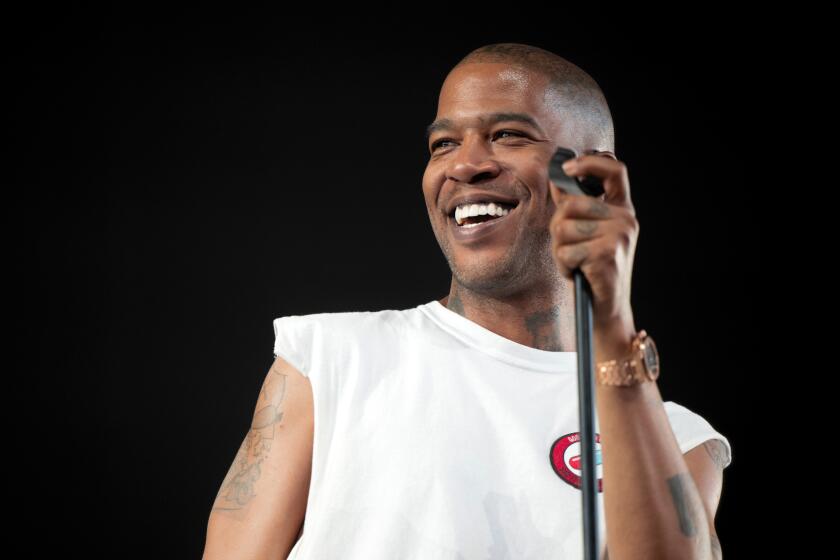Bringing grit back to country music
When Alabama-born singer-songwriter Jamey Johnson went in to record his latest album, “That Lonesome Song,” he had no intention of crafting a collection that would be hailed as one of the best country music efforts of the last year. The studio time was originally conceived as a reunion with old friends, but it also offered Johnson the chance to reclaim a sense of normality -- something he’d lost after a hit single and sudden fame threw his life into chaos.
“We didn’t have a plan, and we didn’t have a record deal. We didn’t even have a reason to go in and make a record,” he said from the road recently before a show in Fort Walton, Fla. “It just had been a long time since I’d seen a lot of my buddies.”
“We started tossing a football around, and passing a bottle of whiskey around, and it was two or two-and-a-half hours before we finally decided to [record] something . . .,” Johnson, 33, recalled. “We sat there and just made music.”
The music that emerged from that session garnered three Grammy Award nominations for country song and male country vocal for the single “In Color,” and country album in a field that pits the relative unknown against such heavyweights as George Strait, Randy Travis, Trisha Yearwood and Patty Loveless.
Those nominations add industry accolades to a work that appeared on many critics’ top 10 lists for its uncompromising look at a life spiraling downward. The album is a bracing yet somehow ultimately uplifting tale told in songs free of the sentimentality and the easy optimism that characterizes much of what’s played on country radio.
It’s structured as a thematically linked piece, a high-concept approach that largely went out of fashion in country circles after Willie Nelson’s watershed examples during the 1970s, “Phases and Stages” and “Red Headed Stranger.” But Johnson and his cohorts, who whimsically started calling themselves the Kent Hardly Playboys, weren’t concerned with what was in fashion.
“We didn’t want to be affected by any outside influences,” Johnson said. “We wanted it to come straight from the musicians, to come straight from our hearts. Even before we were a band together, we came through the honky tonks learning how to play our instruments. This is the kind of music we all wanted to make, even though we’ve run into everything from disrespect to downright discontent for what we did.”
A bumpy road
Much of the source material for the songs on “That Lonesome Song” grew out of Johnson’s own life. A promising talent, he left his hometown of Montgomery, Ala. -- where Hank Williams Sr. also lived and was buried -- for the bright lights of Nashville. There, Johnson scored work as a singer of demo recordings on songs being pitched to other artists, while holding down different day jobs, construction worker among them.
After several years he got a shot at recording something of his own. His 2005 single “The Dollar” clicked with its heart-tugging portrait of a young boy asking his mother how much of his workaholic father’s time and attention he might be able to buy with the loose change he finds in his room.
Mama how much time will this buy me?
Is it enough for just an afternoon, a day or a whole week?
Momentum kept building when Trace Adkins recorded two songs Johnson co-wrote, “Honky Tonk Badonkadonk” and “Ladies Love Country Boys” on his 2006 album “Dangerous Man.” The crowning moment seemed to be when Strait recorded another song Johnson co-wrote -- this one with veterans Bill Anderson and Buddy Cannon -- “Give It Away,” which was recognized as the Country Music Assn.’s song of the year for 2007.
As his career was taking off, his life was falling apart, in no small part because of his wholehearted embrace of the party-hearty lifestyle that his sudden successes made possible for him. His marriage broke up, something that hit him harder than anything he’d encountered during his eight years in the Marine Corps.
“Man, it was a lot,” he said. “ ‘The Dollar’ went on the radio, and right after that here comes ‘Honky Tonk Badonkadonk,’ which I wrote basically as a joke, but it got released and turned into a big hit. Something like that really opens the door to a songwriter’s career. Then ‘Give It Away’ comes up, and I was having so much success as a writer.”
He was not, however, having the same kind of success in terms of sales. Johnson’s 2006 album “The Dollar” sold roughly 80,000 copies, according to Nielsen SoundScan, and he was dropped by his label, BNA Records, that year.
“One thing after another was going so well, but personally I’m dealing with getting dropped off a label and my marriage falling apart,” Johnson said. “I had tremendous highs and tremendous lows at the same time, and if that ain’t the formula for a tornado, I don’t know what is. It was a lot to deal with, so I did what I always do: I tried to get the noise out of my head and get down to music.”
Many record label executives had been hesitant to get involved with Johnson in the wake of all that happened after “The Dollar,” despite the buzz that began building around “That Lonesome Song” after Johnson posted the songs on his website. But Universal Music Group’s Luke Lewis, the maverick executive who also started the boutique Lost Highway label that’s home to outside-the-mainstream acts including Lucinda Williams and Hayes Carll, saw commercial potential in the music.
“He had a little bit of a reputation as a bad boy, but I didn’t care about that,” Lewis said. “In fact, it was a plus for me. A lot of people here at the label had the CD in their cars, and when I heard it, that got me interested in his story.”
Lewis signed Johnson to his Mercury Nashville label and began sending tracks to stations, convinced that “In Color” had a shot at getting airplay on mainstream country radio. While his instinct proved true, “It really was a hard sell,” Lewis said. “It took a good six months to get it going. It stands out; it doesn’t sound like anything else on country radio.”
That attention and various critical tributes have helped “That Lonesome Song” log about 200,000 copies since its release in August, according to Nielsen SoundScan.
Give ‘em the truth
Johnson is a staunch believer in the power of honest emotion expressed honestly, and that raw sincerity is perhaps one of the most appealing aspects of his creative output.
“Musical Prozac is not going to carry that listener for too long,” he said. “I think with the economy getting to be the way that it is . . . that people in general, no matter what type of music they listen to, people are going to be looking for truth in their music . . .
“When stuff don’t make sense and you’re looking for an answer, you want to know there’s somebody out there who feels the same way,” he added. “So I think we’re heading into a time when it’s going to take more than just the feel-good song they play on the drive home to help people understand what’s going on around them.”
For Johnson himself, that source of comfort was Waylon Jennings, who is saluted on “That Lonesome Song” in two songs the late country outlaw recorded in the ‘70s, “Dreaming My Dreams” and “The Door Is Always Open.”
“One of my favorite albums over the years has been that 1975 Waylon record ‘Dreaming My Dreams.’ Like anybody else, when I got down and I was kinda putting my life back together, I turned back to music -- not the stuff I wrote, but the stuff that had inspired me over the years. It got to the point where I would listen to that album two or three times a day and I’d just crawl up in that sound.
“Musicians,” he said, “we don’t usually keep diaries. Our songs are our diaries. Well, he helped me get through a pretty tough time in my life with an album that he made the same year I was born. So we did a couple songs off that album to show my respect to the songs and the men who make that kind of music.”
--
More to Read
The biggest entertainment stories
Get our big stories about Hollywood, film, television, music, arts, culture and more right in your inbox as soon as they publish.
You may occasionally receive promotional content from the Los Angeles Times.






